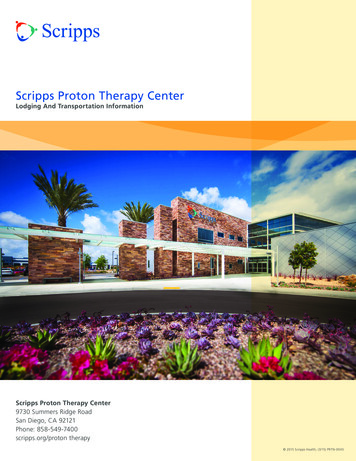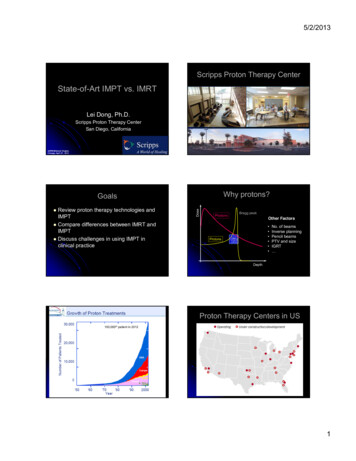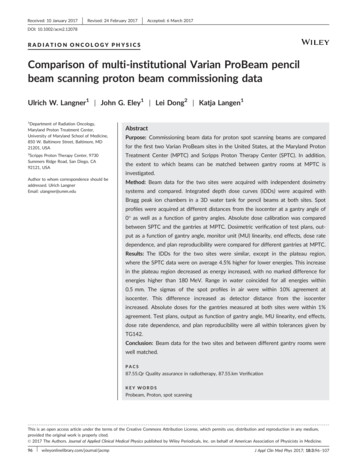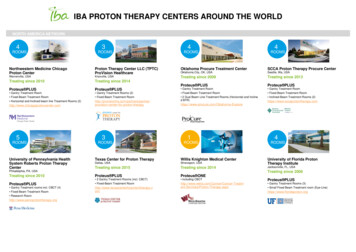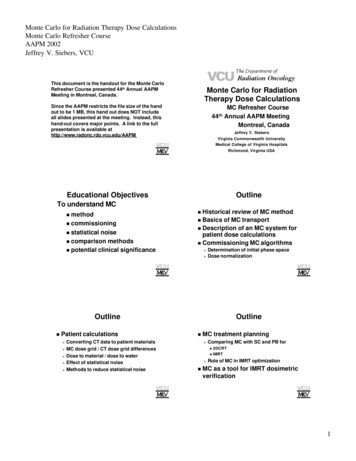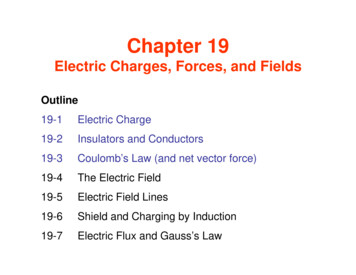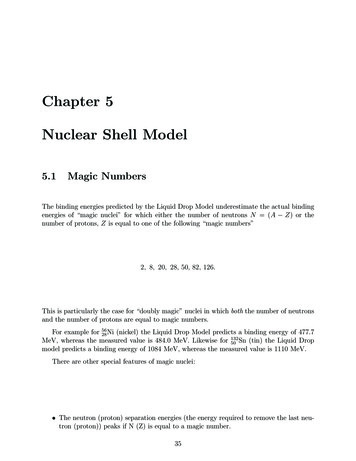
Transcription
Scripps Proton Therapy Center:Configuration and ImplementationAnthony MasciaProton Symposium2013 Annual AAPM MeetingIndianapolis, Indiana USA
Facility Configuration
Scripps Proton Therapy Center***All Rooms : PBS Only360o GantryFixed HorizontalBeamlineCyclotronMax E : 250 MeV
Scripps Proton Therapy Center Gantry-mounted dualx-ray imaging system Full CBCT function Internal and externalimaging console TrueBeam-liketreatment console Robotic, 6-degree offreedom patientpositioner
Scripps Proton Therapy Center Designed treatment capacity: 2400 pts per year Planned patient mix:– Prostate Cancer: 800 patients/year– Lung Cancer: 200 patients/year.– Head & Neck Cancers: 200 patients/year– Pediatric Cancer: 100 patients/year– Breast Cancer: 200 patients/year– CNS Tumors: 400 patients/year– Other tumor sites
Scripps Proton Therapy Center Physicians (4)– Carl Rossi– Huan Giap, Ryan Grover, Andrew Chang Physicists (7)– Lei Dong– Annelise Giebler, Anthony Mascia, Yongbin Zhang, FrankoPiskulich, Richard LePage, Luis Perles Physicist Assistants– To be hired: January 2014 Dosimetrists (2)– First cohort started: July 2013 Radiation Therapists (5)– First cohort started: August 2013
Quality Assurance
Daily Machine QACourtesy PTW Duration 15 minutes; performed by RTTsIn short, an end-to-end test using daily QA detectorRotate proton energy daily, Monday Through FridayPBS volumetric irradiations (i.e. not single spots)Ding X, Zheng Y, Zeidan O, Mascia A, Hsi W, Kang Y, Ramirez E, Schreuder N, Harris B. “A novel daily QAsystem for proton therapy.” J Appl Clin Med Phys. 2013 Mar 4;14(2):4058
Weekly Machine QASummary Comprehensive spot pattern tests– Initially performed: weekly Deliver a fixed spot pattern at two gantryangles, two energies This spot pattern is benchmarked atcommissioning The physical measurement results and theircomparison to benchmark are recorded 30 minutes per roomTest Parameters Position – location of spot on Lynx versusplanned location Shape – ratio of x-axis and y-axis Size – sigma of x-axis and y-axis Output – output constancyCourtesy IBA Dosimetry
Monthly Machine QA The Daily Weekly QAprograms are comprehensiveand reviewed daily/weekly;detailed trend analysisperformed as part of monthlyQAMonthly QA tests a widerspectrum of the beam deliverysystem in one session (e.g.more ranges, more doses, etc)Precise quantification of thetreatment couch usingWinston-Lutz style testsperformed at cardinal gantryanglesImage quality assessment ofthe imaging system
Annual QA As opposed to constancy measurements, theannual QA re-measures / re-validatesbaseline/commissioning data usingcommissioning caliber equipment Detectors:– Water tank Bragg peak chamber– Water tank Farmer chamber– Lynx or Logos scintillator detectors– OctaviusXDR ion chamber array Absolute Calibration: IAEA TRS 398
Patient Specific QA Every field for every patient undergoes quality assurance procedureprior to treatment Procedure highlights:– For each field, three transverse profiles, each at different depth,measured with 2D ion chamber array; compared to calculation inEclipse– For each field, at least one point dose measurement is madeusing cross-calibrated ion chamber (i.e. IBA Dosimetry CC04)– Measurement setup:1. Gantry 0 degrees: all field recalculated to 0 degrees; all fields measured at0 degrees2. Planned Gantry Angle : all fields measured at planned gantry angles andcompared to calculation Passing criteria is being developed– Starting point: 3% / 3mm with 90% passing– Evalute and determine during commissioning and validation
Novel Monthly Machine QA TechniqueCourtesy PTW Use OctaviusXDR or StarCheckMaxi BQ Check phantomUsing single detector, measure: spot position, dose constancy, protonrange/energy, field uniformity (symmetry/flatness)Additional setup (e.g. imaging bb Lynx mounted to gantry) required forWinston Lutz testsTesting/development with Varian, Rinecker Proton Therapy Center and Scripps Proton Therapy Center
Novel QA Implementation Logos Systems Inc XRV device:– Conical scintillator-baseddetector– Alignment: laser, imaging device,and beam isocenter.Isofocus Beam SummaryBeam er @ 0.64 of DE:Laser ErrorZ0.090.41-0.230.23FD FE Laser @X (mm)Y (mm)0.220.0975.7176.3374.840.4369.4479.4575.8464Z (mm)-0.14
Novel Patient QA Technique Aluminum mount interfaces to Varian nozzleOctaviusXDR array rigidly held in place4 x Slide Nuts securely hold up to 25.0cm of solid water in front of the ion chamberarrayAllows transverse plane at any water equivalent depth (up to 25.0cm)Because Varian nozzle holder translates, also allows measurements upstream anddown stream of isocenterThanks to Glen Mounce, machinist
Acknowledgements SPTC Colleagues, especially the physics group:– Lei Dong– Franko Piskulich– Richard LePage– Annelise Giebler– Yongbin Zhang– Luis Perles Our partners at Advanced Particle Therapy (APT) Our partners at Varian Medical Systems, Particle TherapyGroup
Thank you!
Scripps Proton Therapy Center Designed treatment capacity: 2400 pts per year Planned patient mix: - Prostate Cancer: 800 patients/year - Lung Cancer: 200 patients/year. - Head & Neck Cancers: 200 patients/year - Pediatric Cancer: 100 patients/year - Breast Cancer: 200 patients/year - CNS Tumors: 400 patients/year - Other .
